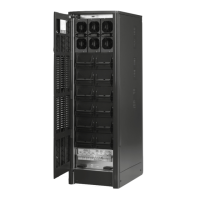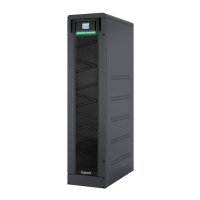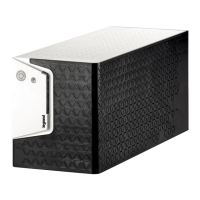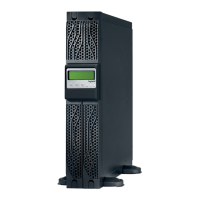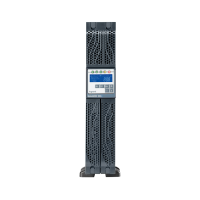Trimod HE
User manual
15
Each command board can manage three power modules. If a command card becomes faulty, only the modules under
its control are put into safe mode and turned off, while the UPS continues to function online, without any interruption
in the load. It is therefore possible to have redundancy on both the individual phase (power module failure) and in the
UPS (command board failure). The replacement of the hot-swap of the power modules is also possible by switching off
the relative control and group of modules attached to it, without having to power the load from the bypass with the
consequent temporary loss of protection.
The command boards are connected to a control panel with display from which it is possible to verify the status and setups
of the UPS and to a communication interface with and RS-232 and SNMP connection, dry contacts and logical contacts. It
is possible to access all the UPS functions from the control panel and communicate through any of the interfaces present
thereby guaranteeing the redundancy of the peripherals as well. In installations with three separate single phase line on
output, it is possible to manage each line independently through the software. For example, it is possible to prioritise the
autonomy of one of them during battery functioning. A bypass input line separated from that of the mains input makes
it possible to supply the bypass with a second power source (the neutral wires of the two lines must be in common).
The technology used in the hardware and the firmware of the UPS represents the current state of the art.
A sophisticated microprocessor-type control optimises the performance of the UPS on the Booster/PFC side and on
the output inverter. The recharge curve of the battery has been designed to get the maximum useful life out of the
accumulators and have the greatest autonomy possible if the main power goes off. The electronic boards are entirely
assembled on LEGRAND automated lines and tested to the highest quality standards. Every device goes through an
extended period of operation at full load before being sent to the customer.
3.2 Features
Modular-redundant architecture
The modular-redundant architecture is the best solution for protecting the nerve centres of a company and has the
following advantages:
- there is one control of the devices supplied;
- modular expandability;
- module redundancy;
- easy maintenance;
- low running cost;
- compactness.
Efficiency
The Trimod HE UPS concentrate particularly on both the energy absorbed from the mains and the energy provided to the
load. They are characterised by high efficiency (up to 96%), PF on input>0.99, THDi <3%.
The advantages of a high efficiency are:
- reduction of the power absorbed from the UPS but not supplied to the load and transmitted to the environment as heat;
- less heat loss transmitted to the environment means reducing the need for ventilation or air conditioning systems in the
installation site;
- no power factor correction cost and so no increase in charges;
- no need to increase the size of any generator upstream of the UPS.
Expandability
Most UPS systems on the market are of the non-modular and non-expandable type thus requiring an initial upscaling of
the system to make future expansions possible.
The advantages of an expandable system are:
- optimisation of investments for UPSs, making them adequate for the current requirements without precluding future
expansions and avoiding wastes of energy;
- increase in the efficiency of the system thanks to proper sizing.
Reliability
To obtain a level of redundancy with traditional UPSs it is necessary to put at least two in parallel thereby doubling the
power acquired, the space occupied and the electricity consumed. Trimod HE’s modular architecture makes it possible to
have redundant configurations within a single cabinet.
The advantages are:
- a UPS with a redundant modular architecture can be configured as an N+X redundant simply by choosing a proper
number of power modules to be installed in the UPS cabinet. Even in the case of a fault in a module, the equipment
continues to function avoiding any downtime;
- clear indications and a large display make it possible to find the fault more quickly;
- the modular architecture makes it possible to speed up the solution to problems through the simple replacement of the
faulty module without interrupting the service;
- high percentage of faults resolved at the first attempt.

